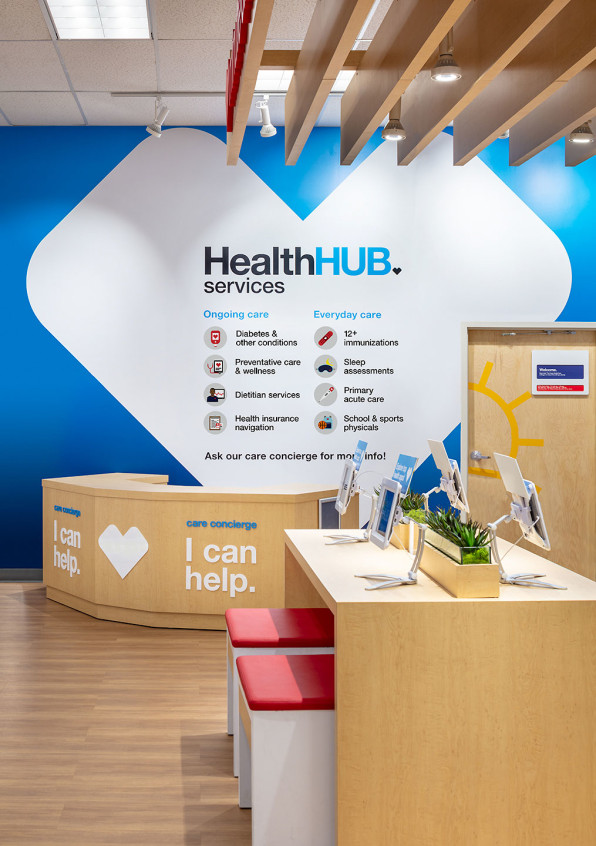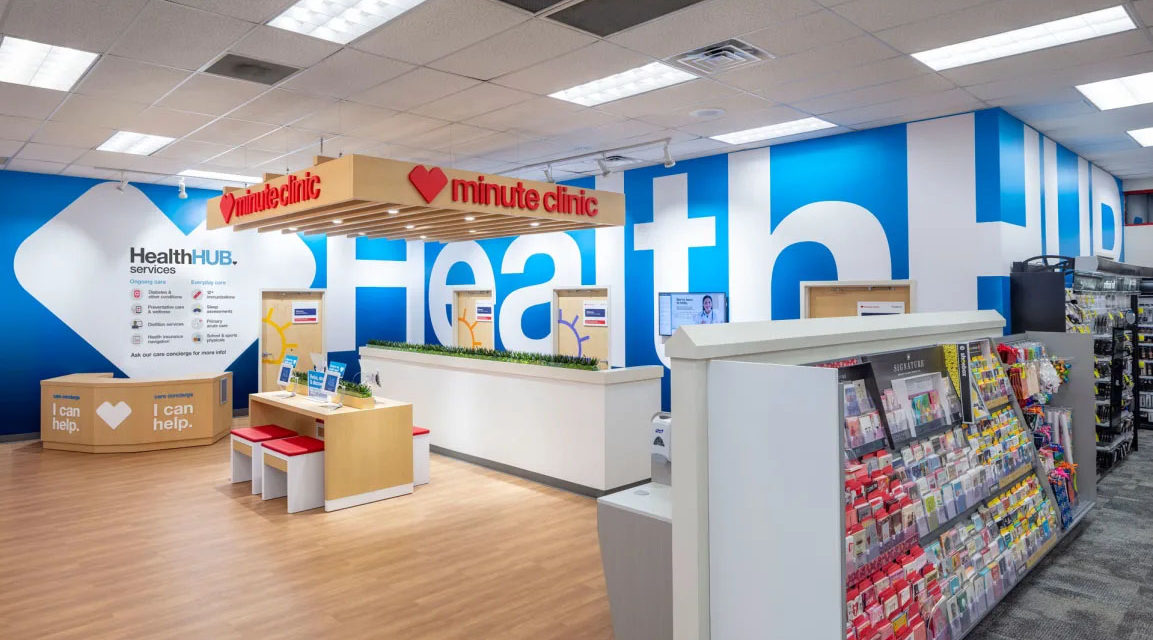[Photo: courtesy of CVS Health]
BY RINA RAPHAEL
Source: fastcompany.com
Chronic diseases are the leading cause of death and disability in the United States, affecting 45% of the population. That’s 133 millionAmericans. And $3.5 trillion in annual healthcare costs.
Plenty of programs, products, and health startups are aimed at lowering the rates of chronic disease—and now CVS Health is hoping to tackle the issue where Americans least expect it: while shopping for toothpaste and toilet paper. The company is currently testing a retail concept dubbed HealthHub. It’s a new kind of healthcare destination that blends the convenience of the pharmacy chain with the ease and familiarity of a neighborhood community center. It’s piloting three HealthHubs, all in Houston.
The HealthHub locations might look like a normal CVS Health, but 20% of the store now offers a broader range of healthcare services, like one-on-one nutritionist counseling and workout classes. There are new product categories, including fitness products (like say, a yoga mat) and an expanded homeopathy category for sleep, anxiety, or memory improvement. In addition, it carries durable medical equipment (wheelchairs and monitors) and supplies for those suffering from conditions such as sleep apnea and diabetes.

These are all items CVS Health has never carried before. Many of them feature an overhead digital screen that highlights the product’s use and efficacy. For those who want to learn more, “learning tables” display multiple iPads where they can discover more about their healthcare needs.
“We are a nonintrusive part of millions of people’s daily lives and so when we interact with them in a healthcare setting, they are already thinking about their health,” explains Alan Lotvin, EVP chief transformation officer for CVS Health, describing the company’s prime positioning.
By delivering more services–which address both the medical contributors of a condition as well as social determinants–CVS Health can help people manage the small daily decisions. Those, in turn, add to up a larger influence on managing chronic disease.
Roughly 70% of diseases in the U.S. are chronic and lifestyle-driven, according to the CDC, and nearly half of the population has one or more chronic health conditions, such as diabetes, asthma, heart disease, obesity, or cancer.
It’s an expensive issue: 86% of annual healthcare costs in the U.S. are driven by chronic disease. Meanwhile, U.S. healthcare expenditures tripled in the last 50 years, from 5% of gross domestic product in 1960 to 17.9% in 2017.
THE GEEK SQUAD FOR HEALTHCARE
Each HealthHub houses a MinuteClinic inside the facility. MinuteClinics are staffed by board-certified nurse practitioners who provide treatments, health screenings, and vaccinations. There are a roughly 1,000 MinuteClinics out of 8,500 stores that CVS Health operates. However, the MinuteClinics found in a HealthHub offer a more comprehensive service, such as more staffed personnel who can answer medical questions as well as nurse practitioners who can do thorough examinations.
There’s even something called the the “pharmacists panel,” in which pharmacists spend a considerable amount of time talking to patients about their lifestyle, medications they’re taking, and what exercises they should be doing.
In addition, a concierge service will schedule free home delivery or set up a monthly shipment of medications sectioned into pouches. They’ll also educate customers on new service offerings and help them navigate in-store services, and even go over their health insurance benefits. It’s a white-glove touch that ensures the community is set up for success.
“We refer to this care concierge as the Geek Squad for healthcare,” jokes Kevin Hourican, president of CVS Pharmacy.
Wellness, which “means lots of different things for different people,” notes Lotvin, is thoroughly ingrained in the program. The $4.2 trillion wellness industry spans multiple categories including fitness, nutrition, mind-body health, and even beauty.
HealthHub narrowed the category down to physical health, emotional health, financial resources, and social connectedness. The team worked with the Harvard School of Public Health to map out a holistic approach to wellness that would resonate with their consumers, many of them middle-age or senior citizens.
For some, it’s an annual diabetic exam or eye exam “right then and there,” notes Hourican. Others are more interested in a nutrition lecture series or a stress-reducing mindfulness class. A senior technology day guides customers through all the questions their grandchildren can’t be bothered to answer. All programs are conducted in designated “wellness rooms” private from the shopping public.
Unsurprisingly, the yoga classes have proven most popular.
“We’re doing yoga classes for people who’ve never done yoga before,” says Lotvin of the senior citizen clientele, many of whom live isolated lives. At hubs they socialize, exercise, and gain more knowledge about their bodies.
So far, 75% of clients who come in for one service end up signing up for another.
“It’s really meant to be a community resource,” says Lotvin. “We want to be a deeper, more relevant part of people’s everyday lives and community, and that means a place where they can learn new things.”
A HEALTHCARE HELPER
Despite all these healthcare services, CVS Health says it in no way wants to replace the role of primary care doctor. Instead, the retailer views itself as complementary to more traditional medical services already available within a community. HealthHub might come in handy in evenings and weekends, when doctors offices are closed, or when a customer might need a non-emergency medical test.
In many ways, HealthHub just adds medical availability and access in the local market, explains Lotvin. CVS Health found that 50% of clients who visited a MinuteClinic don’t have a primary care doctor. And of those, half don’t want one. “This is a way for those people to begin to get really good solid primary care.”
Should a HealthHub nurse practitioner notice a client needs more medical attention or an advanced test, he or she will refer them to a local doctor or specialist. It’s a strategy that has worked well for MinuteClinic (not to mention, eased doctors’ fears they might steal clients). In the last year, MinuteClinic referred 3.4 million primary care patients to local doctors.
“What we’re seeing with big integrated health systems is that they are looking for more efficient ways to deliver primary care,” says Lotvin. “You don’t need a physician to titrate someone’s blood pressure medications. Working in collaboration with a nurse practitioner who puts everything into the electronic medical record is very efficient.”

A recent research report found that America will experience physician shortages in both primary and specialty care in the coming years. It’s estimated we might be short over 120,000 physicians by the end of the next decade. As such, the medical community looks for new, innovative ways to spread care in affordable, accessible manners.In the last year, CVS Health rolled out several new healthcare developments meant to better engage its community base. It now, for example, offers virtual health appointments that allow patients to use telehealth for minor illnesses (such as coughs or colds), injuries, and skin conditions. The company “crushed” first-quarter expectations, with its stock price jumping 4%.
“We’re trying to build the first consumer-centric healthcare company,” stresses Lotvin. “We want to use technologies to bring more services into people’s communities. And we define community as in your hands, in the store, and in your home.”
THE START OF SOMETHING BIG?
CVS Health intends to expand the HealthHub concept to more big cities, although the company hasn’t yet announced specifics. It’s currently focused on Houston, which has one of the highest rates of uninsured residents in a major U.S. city.
The next hubs will target areas with a high prevalence of chronic disease such as an over-penetration of diabetic residents. While the program generally caters to an older demographic, CVS Health will consider catering to other vulnerable groups. It might build a different sort of store in an area that’s heavily populated by millennials, who are quickly moving away from primary care doctors.
CVS Health believes HealthHub can help shift the tide of American health, reimagining where people turn to for care. Already, the company is seeing progress: A customer recently came into a HealthHub complaining she suddenly wasn’t feeling well. After just a few minutes of discussing her symptoms with a nurse practitioner, an ambulance was called. The patient wasn’t properly taking her medication, and after testing her blood sugars and taking her vitals, the staff realized they were imminently dealing with a stroke situation.“It’s one example but a pretty significant one,” says Hourican. “And it’s not the only one. Success stories like this are coming through frequently.” As CVS Health gathers more data on customer preferences and program efficacy, it plans to further tweak the program for those living in direct proximity to these HealthHubs “that have a significant need for help on their path to better health.”

